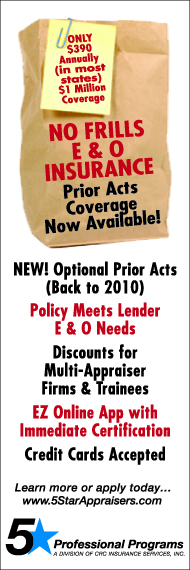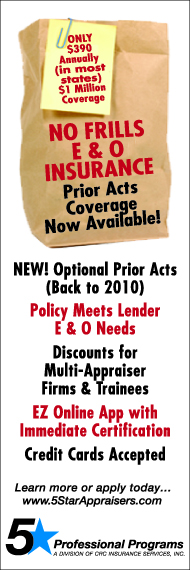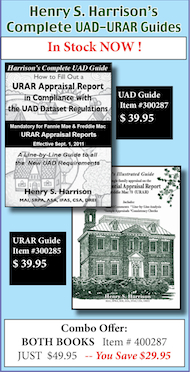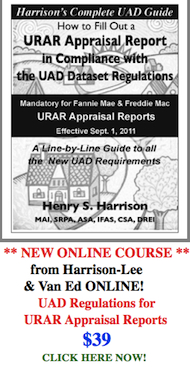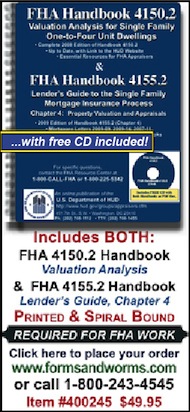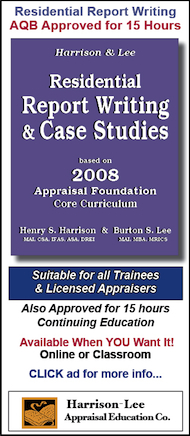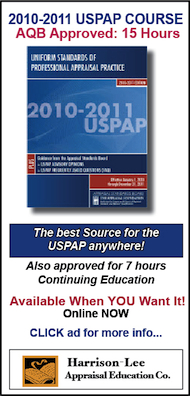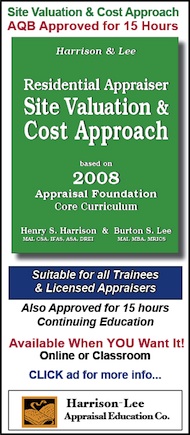Editorial
06/01/11 Categories: Editorial
Who's Against the UAD? (Who's For It?) Stay Tuned...
Two important letters have been written to the General Counsel of the Federal Housing Finance Agency (FHFA) which is the government agency current in charge of Fannie Mae and Freddie Mac because of their dire financial condition. Both of these letters are critical of the UAD and its proposed implementation. One letter is from Ami Mine-Allen, President of the Association of Appraisal Regulatory Officials (AARO). The other is from J. Carl Schultz, Chair of the Appraisal Standards Board (ASB) of the Appraisal Foundation.
It always surprises me how many appraisers are confused about the functions of the Appraisal Foundation, the State Real Estate Appraisal Commissions and their regulatory officials. The Appraisal Foundations creates the standards (USPAP), but has no authority or mechanism to enforce them. The individual state Real Estate Appraisal Commissions and their regulatory officials grant licenses and certifications, and are in charge of enforcing the USPAP along with their "state specific" regulations.
Two important letters have been written to the General Counsel of the Federal Housing Finance Agency (FHFA) which is the government agency current in charge of Fannie Mae and Freddie Mac because of their dire financial condition. Both of these letters are critical of the UAD and its proposed implementation. One letter is from Ami Mine-Allen, President of the Association of Appraisal Regulatory Officials (AARO). The other is from J. Carl Schultz, Chair of the Appraisal Standards Board (ASB) of the Appraisal Foundation.
It always surprises me how many appraisers are confused about the functions of the Appraisal Foundation, the State Real Estate Appraisal Commissions and their regulatory officials. The Appraisal Foundations creates the standards (USPAP), but has no authority or mechanism to enforce them. The individual state Real Estate Appraisal Commissions and their regulatory officials grant licenses and certifications, and are in charge of enforcing the USPAP along with their "state specific" regulations.
The AARO letter was the result of a training session some of the AARO officials attended in Washington, DC. It acknowledges that the UAD is the legitimate creation of Fannie Mae, Freddie Mac and their overseer, the FHFA. The AARO executive committee “echoes the concern...that the UAD program might result in the development and communication of an appraiser’s analysis, opinions and conclusions in a manner that is not meaningful and that may be misleading.” (Emphasis added)
Unfortunately, there is nothing in the letter revealing the basis for their concern, other than the fact that the Appraisal Foundation is concerned. The only thing they suggest is for “FHFA, Fannie Mae and Freddie Mac to proceed with an abundance of caution before finalizing the development of the UAD and the accompanying policies, specifically Appendix D: Field-Specific Standardization Requirements."
I think what they are indirectly asking for is a postponement of the September 1, 2011 mandatory implementation and for something unspecified to be done about Appendix D.
The letter from the Appraisal Foundation seems mostly concerned that “Appendix D will result in unintended consequences and potentially produce misleading reports. Given the prescribed field-specific requirements expressed in the UAD and overall lack of instruction for situations where data is not applicable or unavailable in the normal course of business, appraisers may have to choose between compliance with USPAP or compliance with Fannie Mae and Freddie Mac reporting requirements.”
In my opinion, the Appraisal Foundation's letter is misleading as it claims that there is a space limitation to what an appraiser can say about the “View” and some other specific items. In fact, there is ample room on the Additional Comments lines and in the addenda of the report to completely explain anything the appraiser thinks is necessary to make a credible appraisal report — even when the subject is a very complex property.
It is reasonable to assume that Fannie Mae, Freddie Mac, FHA and VA — who all are committed to the use of the UAD — will use computers to help them analyze the resulting appraisal reports. These computers will rely heavily on the check box answers and standard abbreviations that are required. Computers will be hard put to analyze the comments made by the appraiser in the Additional Comments section and the addenda of the appraisal report. Some other mechanism for dealing with those comments will have to become part of the process of analyzing and reviewing UAD appraisal reports. This shouldn't be too difficult to implement.
On the other hand, the complaints about Appendix D are well taken. Despite Fannie Mae's claims to the contrary, very few appraisers will be able to comply with the complex form filling requirements of the UAD based solely on what is provided in Appendix D. It is hard to apply the general instructions in each section of Appendix D to what you need to know to fill out a specific line on the URAR. Even though I consider myself an expert on how to fill out the URAR form, I found their examples very confusing. Another problem with Appendix D is that it doesn’t ever mention the Cost or Income Approaches, but the UAD has specific requirements for filling out these sections of the appraisal if the appraiser feels they are necessary in order to make a credible appraisal. This is only one example of many other things that are not covered in the Appendix D.
However, this is nothing new with Fannie Mae and Freddie Mac. This is why there are many seminars and courses on how to fill out the URAR and my URAR Illustrated Guide has sold over 100,000 copies. There will be a variety of training opportunities on how to comply with the UAD, from online classes, webinars to classes in community colleges and at appraisal organization meetings. My new book, “Harrison's Complete UAD Guide” — like my URAR Guide — covers all the UAD requirements on a line-by line-basis. When you need information about a specific UAD checkbox or line, all you have to do is go to the specific check box or line in the Guide for all the instructions you need to comply.
I believe that Fannie Mae and Freddie Mac are on the right track with the UAD and they made a wise decision (based on the urging of the software vendors) not to create a new form, but live within the constraints of the 2005 URAR.
So far there is no sign that the mandatory effective date for the UAD of September 1, 2011 is going to be extended, despite the "concerned letters" from AARO and the Appraisal Foundation. My recommendation, therefore, is to acquire the needed software as soon as you can and promptly begin using it in order to be ready for the impending deadline. Note that you will have to use software specially designed for the UAD.
Good luck!
H2




